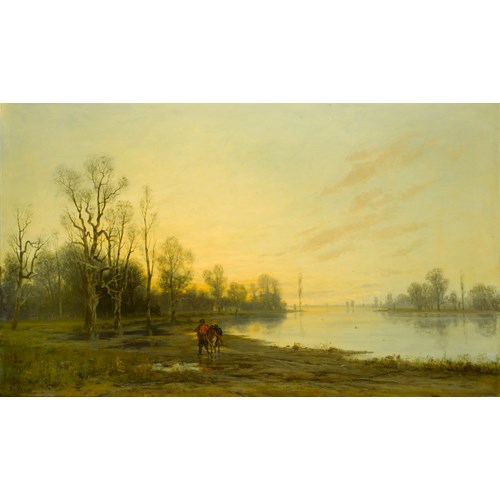Marketplace
The Finding of Moses
Jacob de Backer
The Finding of Moses
Epoque 1400-1600, 16th Century
Origine Belgium
Medium Oil on panel
Dimension 95.5 x 162 cm (37⁵/₈ x 63³/₄ inches)
This interpretation of The Finding of Moses is an elegant and harmonious composition. The scene depicts the discovery of the baby Moses, his mother having hidden him in the reeds by a riverbank to avoid the persecution of the Hebrews by the Pharaoh. The story is told in Exodus 2: 3-9 and narrates that one day the daughter of the Pharaoh came to bathe in the river, and having spied the basket in the reeds sent her servant woman to fetch it. Miriam, the sister of Moses, approached the Pharaoh’s daughter and offered to find a Hebrew woman to nurse the baby for her, and subsequently returned with her mother. When the child grew up, his mother returned Moses to the Pharaoh’s daughter, and he became her son. She named him Moses, ‘Because,’ she said, ‘I drew him out of the water’.
Central to the composition is the seated figure of the Pharaoh’s daughter. Gracefully dressed and wearing a crown, a servant girl stands behind her, fanning her with a canopy of feathers. The Pharaoh’s daughter speaks with a woman dressed in a flowing yellow and white dress, whose cupped exposed left breast and covered head indicate that she is Moses’ mother offering to nurse the child. Between the two conversing figures a younger woman, presumably Miriam, listens intently. The baby Moses is laid down by two servant women, whilst another points to the location of his hiding. Alongside the river, the scene of his discovery is additionally depicted as two ladies pull the baby from the reed bed. In the background on the left, a mythical city is shrouded in mist, whilst on the right one can see the formal garden of a classically designed villa.
Attributed to Jacob de Backer, The Finding of Moses is closely comparable in style and execution with de Backer’s The Three Stages of Man in the Hermitage Collection. In both paintings, the drapery is crisp and buoyant, the strong, muscular figures are reminiscent of Michelangelo, and the central grouping of intertwined and interactive figures dominate the composition. Furthermore, there are noticeable facial similarities in the female figures in both works.
Jacob de Backer lived only to the age of thirty, and despite a short period of productivity, there are a relatively high number of works ascribed to him. According to the Flemish biographer Karel van Mander (1548-1606), de Backer was abandoned by his father as a young boy. He then worked in the studio of Antonio van Palermo (1503/13-before 1589) and later entered the workshop of Hendrick van Steenwijck the Elder (1550-1603). Van Mander claimed that de Backer’s early death was caused by the strenuous labour imposed on the young artist in van Palermo’s studio.
Little is known about the artist’s training, though it seems that he never became a master in the Guild of St. Luke. His work is evidently influenced by the Mannerism of Rome and Florence, in particular by Giorgio Vasari (1511-1574) and his generation, but there is no real evidence that de Backer ever visited Italy. Many of his compositions have complex allegorical subjects, which may indicate that he had a humanistic education and that his clientele was drawn from the Antwerp intelligentsia.
Central to the composition is the seated figure of the Pharaoh’s daughter. Gracefully dressed and wearing a crown, a servant girl stands behind her, fanning her with a canopy of feathers. The Pharaoh’s daughter speaks with a woman dressed in a flowing yellow and white dress, whose cupped exposed left breast and covered head indicate that she is Moses’ mother offering to nurse the child. Between the two conversing figures a younger woman, presumably Miriam, listens intently. The baby Moses is laid down by two servant women, whilst another points to the location of his hiding. Alongside the river, the scene of his discovery is additionally depicted as two ladies pull the baby from the reed bed. In the background on the left, a mythical city is shrouded in mist, whilst on the right one can see the formal garden of a classically designed villa.
Attributed to Jacob de Backer, The Finding of Moses is closely comparable in style and execution with de Backer’s The Three Stages of Man in the Hermitage Collection. In both paintings, the drapery is crisp and buoyant, the strong, muscular figures are reminiscent of Michelangelo, and the central grouping of intertwined and interactive figures dominate the composition. Furthermore, there are noticeable facial similarities in the female figures in both works.
Jacob de Backer lived only to the age of thirty, and despite a short period of productivity, there are a relatively high number of works ascribed to him. According to the Flemish biographer Karel van Mander (1548-1606), de Backer was abandoned by his father as a young boy. He then worked in the studio of Antonio van Palermo (1503/13-before 1589) and later entered the workshop of Hendrick van Steenwijck the Elder (1550-1603). Van Mander claimed that de Backer’s early death was caused by the strenuous labour imposed on the young artist in van Palermo’s studio.
Little is known about the artist’s training, though it seems that he never became a master in the Guild of St. Luke. His work is evidently influenced by the Mannerism of Rome and Florence, in particular by Giorgio Vasari (1511-1574) and his generation, but there is no real evidence that de Backer ever visited Italy. Many of his compositions have complex allegorical subjects, which may indicate that he had a humanistic education and that his clientele was drawn from the Antwerp intelligentsia.
Epoque: 1400-1600, 16th Century
Origine: Belgium
Medium: Oil on panel
Dimension: 95.5 x 162 cm (37⁵/₈ x 63³/₄ inches)
Plus d'œuvres d'art de la Galerie









